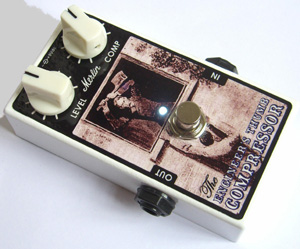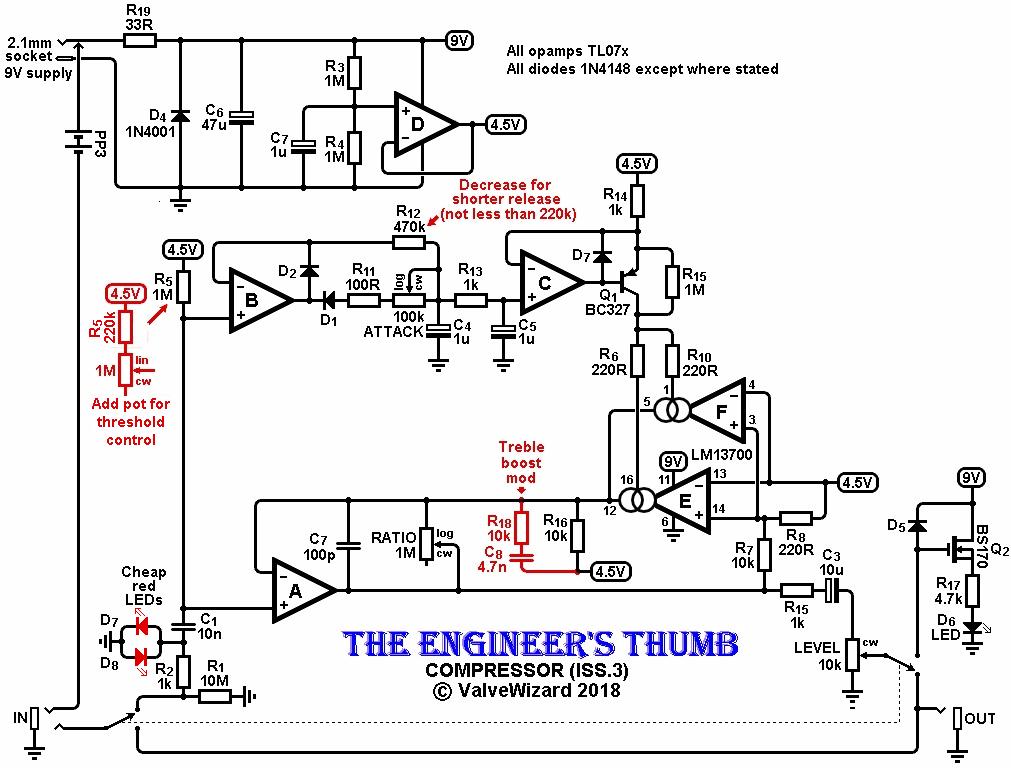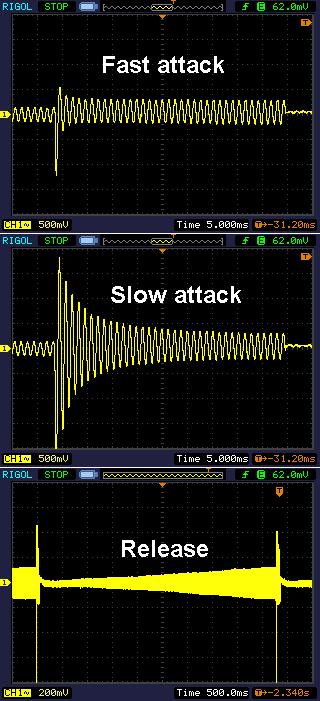|
The Engineer's Thumb: LM13700 Compressor / Sustainer
 The Engineer's Thumb is a better compressor. It combines all the best features of the popular DIY compressors, without any of the sacrifices.
It is built around an LM13700 Operational Transconductance Amplifier (OTA). This is functionally equivalent to the now-obsolete
CA3080, which was famously used in the MXR Dynacomp (the Dynacomp works equally well with an LM13700, and it's half the price, so you
will find it in some Dynacomp clones such as the Visual Sound Comp-66).
The Engineer's Thumb is a better compressor. It combines all the best features of the popular DIY compressors, without any of the sacrifices.
It is built around an LM13700 Operational Transconductance Amplifier (OTA). This is functionally equivalent to the now-obsolete
CA3080, which was famously used in the MXR Dynacomp (the Dynacomp works equally well with an LM13700, and it's half the price, so you
will find it in some Dynacomp clones such as the Visual Sound Comp-66).
Actually, the majority of guitar compressors currently on the market are Dynacomp clones. Just looking in my local music store
at least five out of the thirteen compressors they offer are Dynacomp clones; everything from the Behringer DC9 (£20) to the BBE Bench Press (£144)
(five of the others are optical compressors, one is digital, one is VCA and the other two I'm not sure about ).
Therefore, when I set out to build a better compressor, I knew it had to be capable of matching the Dynacomp, but with some sort of advantage over it, otherwise there would be no point.
As it turned out the Engineer's Thumb has almost every advantage over it; five times more headroom, about half the noise,
and the capability for all five compressor controls. And, believe it or not, it also costs less and uses fewer parts!
A fully-featured compressor will offer controls for:
Attack- The time it takes for the compression to kick in when a loud sound comes along.
Release- The time it takes for the gain to recover after the loud sound has passed.
Threshold- How big the input signal has to be before compression can happen. In most stompboxes -including the Dynacomp-
this will simply be labelled "compression" or "sustain" or something.
Ratio- How much the gain reduces during compression. At the extreme we get limiting, where the output signal is
maintained at a constant level no matter what the input level. This is exactly what you want for maximum sustain (incidentally, the Dynacomp is a limiter).
Level/volume- You know what this does; compressing a signal makes it sound quieter, so you need some gain to bring the subjective
level back to normal. In a compressor this may be called make-up gain.
With the Engineer's Thumb you can adjust all these parameters very easily to suit your taste; in most cases only a single resistor needs to be changed (see schematic).
Units offering all of these things are sometimes called 'five-knob' compressors. There are very, very few guitar pedals
that offer all five; most have threshold and level only. A few also have attack (although more often than not it is actually a mis-named release control!).
However, it is worth noting that there is little need for both threshold and ratio in a guitar compressor;
the same sounds can usually be obtained with either.
In terms of cost/performance ratio, the Dynacomp was an astonishingly good design for its era. However, it shows its age, and the
main objection to it is its noise floor. This is because OTAs are fundamentally noisy beasts, and when the circuit is not
amplifying a signal the OTA is just sitting there running at max gain, producing its maximum amount of output noise.
An obvious solution is to place the OTA in the feedback loop of an opamp, so the situation is reversed. Now when the circuit gain
is highest the OTA gain must be lowest (restricting the amount of feedback), so its noise is also lowest. This is exactly how the
Engineer's Thumb works; the OTA acts like a current-controlled feedback resistor.

How it Works
Opamp A and the transconductance amp form a current-controlled gain block. The 100pF feedback capacitor stabilises the circuit at high frequencies.
The ratio control works by introducing a fixed feedback resistance in parallel with the OTA, effectivedly blending uncompressed
signal with the compressed response.
In the latest issue of the circuit I have connected both sections E/F of the LM13700 in parallel to acheive even lower noise (it's a shame to waste that extra section, right?).
R6 and R10 ensure the control current splits equally between the two sections.
The input signal is fed directly to the side chain. If you want a threshold control then replace the 1M pull-up resistor
with a 1M linear pot as shown, so the signal being fed to B is variable. B is a precision half-wave rectifier; at idle the
voltage on the 1uF caps is 4.5V, but when a signal comes in the voltage is pumped down. Two capacitors
are used here to provide double filtering, reducing control voltage ripple.
If used with bass guitar I recommend increasing one or both of these caps to 2.2u, and reducing the release resistor to 220k.
The voltage on the second 1uF cap is sent to C which, together with the BC327, forms a precision current source that
dumps more current into the OTA's control pin as the audio signal gets louder.
This increases the OTA's gain which in turn reduces the gain of A. Any general purpose PNP transistor will work here.
Opamp D provides the necessary 4.5V reference voltage which must be rock-steady despite the current being sucked out of it
for the OTA.
The compressed output signal from A is sent straight to the output level pot via a 1k build-out resistor that
protects against the effects of cable capacitance, which will otherwise cause oscillation.

Performance
An important feature of this circuit is that the side chain is feedforward. Most compressors use a
feedback approach, where the amount of compression is determined by the signal level already at the output.
This is simpler to arrange but technically inferior as it carries the massive disadvantage that you get overcompression on long attack times. In other words, the sound goes
unnaturally quiet just after a loud transient, and then slowly returns, creating annoying pumping effects. This is why most
pedal compressors don't let you control the attack- it is set permanently fast. With feedforward compression you don't
get this problem, so you can have any attack time you want.
The image on the right shows what happens when a 15mVpp signal (below threshold) jumps up to 150mVpp (above threshold), with the ratio set for maximum compression.
The minimum attack time is less than 3ms, which is almost unnoticeable. This gives the smoothest, most fluid playing, just like a Dynacomp.
The maximum attack time (using the recommended 100k pot) is about 20ms, resulting in much less compression during individual notes and choppy playing.
Only with sustained sound does compression kick in.
The release time is set to 4 seconds which works best with my Les Paul, giving the longest, smoothest sustain.
However, other guitars and playing styles may prefer a shorter relase time -you can try different values as indicated on the schematic above.
The raw circuit has a total input headroom of about 5Vp-p, which is five times more than the average effects pedal! However,
because of the OTA in the feedback loop, the circuit does not clip at all gracefully, and may even oscillate at some settings
if overdriven. With so much headroom no ordinary guitar will manage this, but if you put a booster in front then it could be a problem.
To fix this, a pair of standard red LEDs should be added in anti-parallel as shown.
These will prevent the input signal from exceeding about 3Vp-p, resulting in graceful overload. I highly recommend them.
A lot of people also like some treble boost in a compressor, for some extra sparkle. This is easily added with the treble
boost mod as shown. If used with bass guitar, increase the 4.7nF cap to 10nF.
Incidentally, if you're wondering why it's called the engineer's thumb, it is named after a Sherlock Holmes story in which the poor engineer is almost crushed to death in a giant
press (press, compressor, geddit?). Also I designed the circuit by starting with some basic electronic engineering rules of thumb, like putting the OTA in a feedback loop.
Technical details:
Input impedance = 1M ohms
Output impedance = <2.5k ohms
Current consumption = 10mA when active.
I sometimes have PCBs available in my shop;
user guide here.
NOTE: Iss.3 PCBs have a duplicate resistor labelled R19 (in between R15 and R7). This resistor is not required!
If you want to etch your own PCB, check out the old engineer's thumb page.
Here is a soundclip. The first half of the clip is the original signal recorded into my computer. The second half is played back through the compressor on the maximum setting (no treble boost mod). Note that most of the hiss is actually from the original recording being amplified by the compressor, rather than coming from the compressor itself.
|  The Engineer's Thumb is a better compressor. It combines all the best features of the popular DIY compressors, without any of the sacrifices.
It is built around an LM13700 Operational Transconductance Amplifier (OTA). This is functionally equivalent to the now-obsolete
CA3080, which was famously used in the MXR Dynacomp (the Dynacomp works equally well with an LM13700, and it's half the price, so you
will find it in some Dynacomp clones such as the Visual Sound Comp-66).
The Engineer's Thumb is a better compressor. It combines all the best features of the popular DIY compressors, without any of the sacrifices.
It is built around an LM13700 Operational Transconductance Amplifier (OTA). This is functionally equivalent to the now-obsolete
CA3080, which was famously used in the MXR Dynacomp (the Dynacomp works equally well with an LM13700, and it's half the price, so you
will find it in some Dynacomp clones such as the Visual Sound Comp-66).

